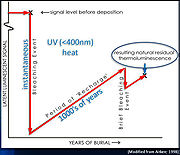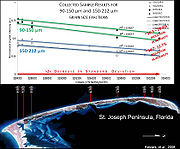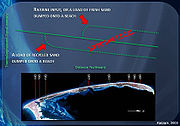
Thermoluminescence dating
Encyclopedia




Radiation
In physics, radiation is a process in which energetic particles or energetic waves travel through a medium or space. There are two distinct types of radiation; ionizing and non-ionizing...
dose, of the time elapsed since material containing crystal
Crystal
A crystal or crystalline solid is a solid material whose constituent atoms, molecules, or ions are arranged in an orderly repeating pattern extending in all three spatial dimensions. The scientific study of crystals and crystal formation is known as crystallography...
line minerals was either heat
Heat
In physics and thermodynamics, heat is energy transferred from one body, region, or thermodynamic system to another due to thermal contact or thermal radiation when the systems are at different temperatures. It is often described as one of the fundamental processes of energy transfer between...
ed (lava
Lava
Lava refers both to molten rock expelled by a volcano during an eruption and the resulting rock after solidification and cooling. This molten rock is formed in the interior of some planets, including Earth, and some of their satellites. When first erupted from a volcanic vent, lava is a liquid at...
, ceramic
Ceramic
A ceramic is an inorganic, nonmetallic solid prepared by the action of heat and subsequent cooling. Ceramic materials may have a crystalline or partly crystalline structure, or may be amorphous...
s) or exposed to sunlight (sediment
Sediment
Sediment is naturally occurring material that is broken down by processes of weathering and erosion, and is subsequently transported by the action of fluids such as wind, water, or ice, and/or by the force of gravity acting on the particle itself....
s). As the material is heated, during measurements, thermoluminescence
Thermoluminescence
Thermoluminescence is a form of luminescence that is exhibited by certain crystalline materials, such as some minerals, when previously absorbed energy from electromagnetic radiation or other ionizing radiation is re-emitted as light upon heating of the material...
, a weak light signal, is emitted, proportional to the radiation dose absorbed by the material.
Natural crystalline materials contain imperfections: impurity ion
Ion
An ion is an atom or molecule in which the total number of electrons is not equal to the total number of protons, giving it a net positive or negative electrical charge. The name was given by physicist Michael Faraday for the substances that allow a current to pass between electrodes in a...
s, stress dislocations, and other phenomena that disturb the regularity of the electric field
Electric field
In physics, an electric field surrounds electrically charged particles and time-varying magnetic fields. The electric field depicts the force exerted on other electrically charged objects by the electrically charged particle the field is surrounding...
that holds the atom
Atom
The atom is a basic unit of matter that consists of a dense central nucleus surrounded by a cloud of negatively charged electrons. The atomic nucleus contains a mix of positively charged protons and electrically neutral neutrons...
s in the crystalline lattice together. This leads to local humps and dips in its electric potential
Electric potential
In classical electromagnetism, the electric potential at a point within a defined space is equal to the electric potential energy at that location divided by the charge there...
. Where there is a dip (a so-called "electron
Electron
The electron is a subatomic particle with a negative elementary electric charge. It has no known components or substructure; in other words, it is generally thought to be an elementary particle. An electron has a mass that is approximately 1/1836 that of the proton...
trap"), a free electron
Electron
The electron is a subatomic particle with a negative elementary electric charge. It has no known components or substructure; in other words, it is generally thought to be an elementary particle. An electron has a mass that is approximately 1/1836 that of the proton...
may be attracted and trapped. The flux of ionizing radiation—both from cosmic radiation and from natural radioactivity—excites electrons from atoms in the crystal lattice into the conduction band
Conduction band
In the solid-state physics field of semiconductors and insulators, the conduction band is the range of electron energies, higher than that of the valence band, sufficient to free an electron from binding with its individual atom and allow it to move freely within the atomic lattice of the material...
where they can move freely. Most excited electrons will soon recombine with lattice ions, but some will be trapped, storing part of the energy
Energy
In physics, energy is an indirectly observed quantity. It is often understood as the ability a physical system has to do work on other physical systems...
of the radiation in the form of trapped electric charge
Electric charge
Electric charge is a physical property of matter that causes it to experience a force when near other electrically charged matter. Electric charge comes in two types, called positive and negative. Two positively charged substances, or objects, experience a mutual repulsive force, as do two...
(Figure 1). Depending on the depth of the traps (the energy required to free an electron from them) the storage time of trapped electrons will vary - some traps are sufficiently deep to store charge for hundreds of thousands of years.
In thermoluminescence dating, these long-term traps are used to determine the age of materials: When irradiated crystalline material is again heated or exposed to strong light, the trapped electrons are given sufficient energy to escape. In the process of recombining with a lattice ion, they lose energy and emit photon
Photon
In physics, a photon is an elementary particle, the quantum of the electromagnetic interaction and the basic unit of light and all other forms of electromagnetic radiation. It is also the force carrier for the electromagnetic force...
s (light quanta
Quantum
In physics, a quantum is the minimum amount of any physical entity involved in an interaction. Behind this, one finds the fundamental notion that a physical property may be "quantized," referred to as "the hypothesis of quantization". This means that the magnitude can take on only certain discrete...
), detectable in the laboratory
Laboratory
A laboratory is a facility that provides controlled conditions in which scientific research, experiments, and measurement may be performed. The title of laboratory is also used for certain other facilities where the processes or equipment used are similar to those in scientific laboratories...
. The amount of light produced is proportional to the number of trapped electrons that have been freed which is in turn proportional to the radiation dose accumulated. In order to relate the signal (the thermoluminescence—light produced when the material is heated) to the radiation dose that caused it, it is necessary to calibrate the material with known doses of radiation since the density
Density
The mass density or density of a material is defined as its mass per unit volume. The symbol most often used for density is ρ . In some cases , density is also defined as its weight per unit volume; although, this quantity is more properly called specific weight...
of traps is highly variable.
Thermoluminescence dating presupposes a "zeroing" event in the history of the material, either heating (in the case of pottery or lava) or exposure to sunlight (in the case of sediments), that removes the pre-existing trapped electrons. Therefore, at that point the thermoluminescence signal is zero. As time goes on, the ionizing radiation field around the material causes the trapped electrons to accumulate (Figure 2). In the laboratory, the accumulated radiation dose can be measured, but this by itself is insufficient to determine the time since the zeroing event. The radiation dose rate - the dose accumulated per year-must be determined first. This is commonly done by measurement of the alpha radioactivity
Alpha particle
Alpha particles consist of two protons and two neutrons bound together into a particle identical to a helium nucleus, which is classically produced in the process of alpha decay, but may be produced also in other ways and given the same name...
(the uranium
Uranium
Uranium is a silvery-white metallic chemical element in the actinide series of the periodic table, with atomic number 92. It is assigned the chemical symbol U. A uranium atom has 92 protons and 92 electrons, of which 6 are valence electrons...
and thorium
Thorium
Thorium is a natural radioactive chemical element with the symbol Th and atomic number 90. It was discovered in 1828 and named after Thor, the Norse god of thunder....
content) and the potassium
Potassium
Potassium is the chemical element with the symbol K and atomic number 19. Elemental potassium is a soft silvery-white alkali metal that oxidizes rapidly in air and is very reactive with water, generating sufficient heat to ignite the hydrogen emitted in the reaction.Potassium and sodium are...
content (K-40 is a beta
Beta particle
Beta particles are high-energy, high-speed electrons or positrons emitted by certain types of radioactive nuclei such as potassium-40. The beta particles emitted are a form of ionizing radiation also known as beta rays. The production of beta particles is termed beta decay...
and gamma
Gamma ray
Gamma radiation, also known as gamma rays or hyphenated as gamma-rays and denoted as γ, is electromagnetic radiation of high frequency . Gamma rays are usually naturally produced on Earth by decay of high energy states in atomic nuclei...
emitter
Emitter
-In general:*A device used to exude any signal, beacon, light, odor, liquid, fragrance, ionizing particles or any other type of signal.-In horticulture:*A device used in drip irrigation.-In electronics and instrument physics:...
) of the sample material. Often the gamma radiation field at the position of the sample material is measured, or it may be calculated from the alpha radioactivity and potassium content of the sample environment, and the cosmic ray
Cosmic ray
Cosmic rays are energetic charged subatomic particles, originating from outer space. They may produce secondary particles that penetrate the Earth's atmosphere and surface. The term ray is historical as cosmic rays were thought to be electromagnetic radiation...
dose is added in. Once all components of the radiation field are determined, the accumulated dose from the thermoluminescence measurements is divided by the dose accumulating each year, to obtain the years since the zeroing event.
Thermoluminescence dating is used for material where radiocarbon dating
Radiocarbon dating
Radiocarbon dating is a radiometric dating method that uses the naturally occurring radioisotope carbon-14 to estimate the age of carbon-bearing materials up to about 58,000 to 62,000 years. Raw, i.e. uncalibrated, radiocarbon ages are usually reported in radiocarbon years "Before Present" ,...
is not available, like sediments. Its use is now common in the authentication of old ceramic wares, for which it gives the approximate date of the last firing. An example of this can be seen in Rink and Bartoll, 2005. Thermoluminescence dating was modified for use as a passive sand migration analysis tool by Keizars, et al., 2008 (Figure 3), demonstrating the direct consequences resulting from the improper replenishment of starving beaches using fine sands, as well as providing a passive method of policing sand replenishment and observing riverine or other sand inputs along shorelines (Figure 4).
Optical dating
Optical dating
Optical dating is a method of determining how long ago minerals were last exposed to daylight. It is useful to geologists and archaeologists who want to know when such an event occurred....
is a related measurement method which replaces heating with exposure to intense light. The sample material is illuminated with a very bright source of infrared light (for feldspars) or green or blue light (for quartz
Quartz
Quartz is the second-most-abundant mineral in the Earth's continental crust, after feldspar. It is made up of a continuous framework of SiO4 silicon–oxygen tetrahedra, with each oxygen being shared between two tetrahedra, giving an overall formula SiO2. There are many different varieties of quartz,...
). Ultraviolet light emitted by the sample is detected for measurement.
See also
- GeochronologyGeochronologyGeochronology is the science of determining the age of rocks, fossils, and sediments, within a certain degree of uncertainty inherent to the method used. A variety of dating methods are used by geologists to achieve this, and schemes of classification and terminology have been proposed...
- ThermoluminescenceThermoluminescenceThermoluminescence is a form of luminescence that is exhibited by certain crystalline materials, such as some minerals, when previously absorbed energy from electromagnetic radiation or other ionizing radiation is re-emitted as light upon heating of the material...
- Thermoluminescent dosimeterThermoluminescent DosimeterA thermoluminescent dosimeter, or TLD, is a type of radiation dosimeter. A TLD measures ionizing radiation exposure by measuring the amount of visible light emitted from a crystal in the detector when the crystal is heated. The amount of light emitted is dependent upon the radiation exposure...
- Rehydroxylation datingRehydroxylation datingRehydroxylation [RHX] dating is a developing technology for dating fired clay ceramics. It is based on the principle that after a ceramic is removed from the kiln, it immediately begins to recombine chemically with moisture from the environment and thus increases in weight. This weight increase...

